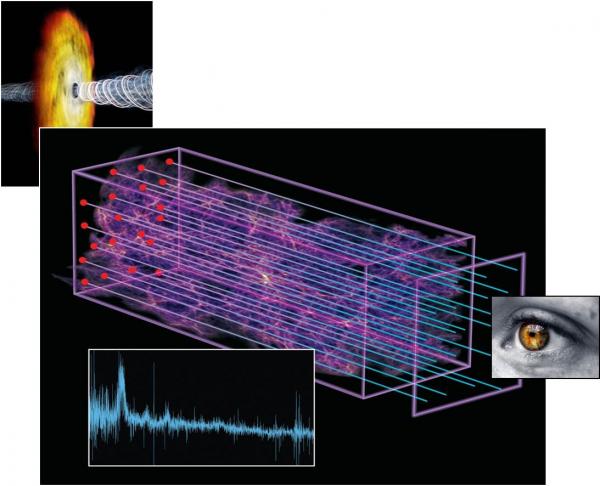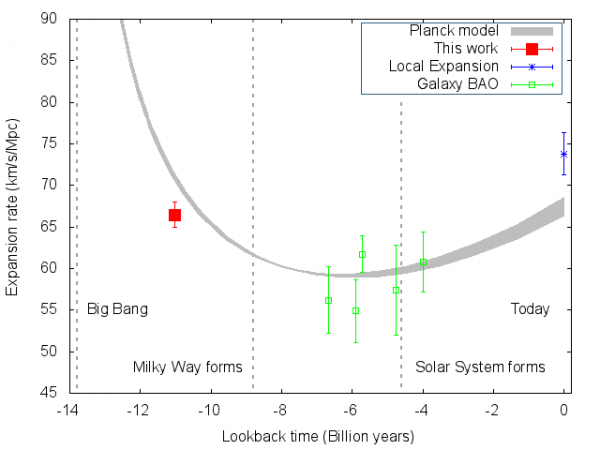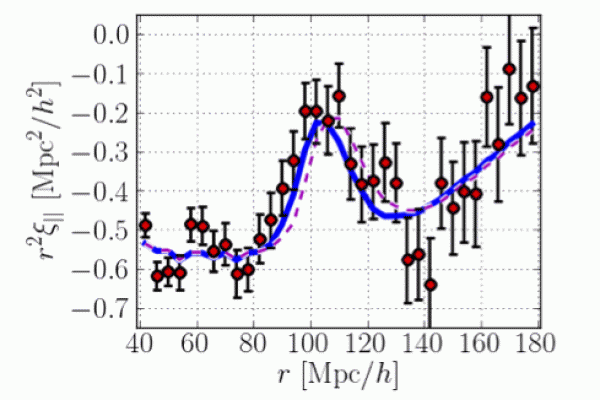
Light from distant quasars (the red dots on the left) is partially absorbed as it passes through intergalactic hydrogen clouds (center). This phenomenon creates a "forest" of absorption lines, which can be interpreted to create an intergalactic gas map.
Astronomers at the Sloan Digital Sky Survey (SDSS) used 140,000 distant quasars to measure the rate of expansion of the Universe when it was only a quarter of its present age. This is the best measure of the rate of expansion at any time in the 13 billion years since the Big Bang. Researchers from Irfu (CEA) and CNRS played a major role in this discovery.
The Baryon Oscillation Spectroscopic Survey (BOSS), the main component of the third generation of SDSS surveys, was the first to use gigantic quasar transmitters to map the distribution of intergalactic hydrogen gas and thus measure the structure of the young Universe. The selection of the objects to be observed is carried out by researchers from the Research Institute on the Fundamental Laws of the Universe (CEA) and the final BOSS quasar catalog is produced by researchers from the Astroparticle and Cosmology Laboratory (CNRS/CEA/University Paris Diderot/Observatoire de Paris/CNES) and the Paris Astrophysics Institute (CNRS/Université Pierre et Marie Curie).
Three years ago, BOSS used 14,000 quasars to produce the largest 3D maps of the Universe.
Two years ago, with 48,000 quasars, it detected baryonic acoustic oscillations in these maps, which are evidence of the inhomogeneities of the primordial universe. Today, with more than 140,000 quasars, he has obtained extremely precise measurements of the size of these structures, which were presented at the April 2014 meeting of the American Physical Society in Savannah, Georgia.
These latest results were obtained by an international team, led by researchers from the CEA and CNRS, who studied the distribution of hydrogen gas that makes it possible to measure distances in the young Universe. A second team, led by the Lawrence Berkeley National Laboratory, compares the distribution of quasars to the distribution of hydrogen gas. Combined, the two BOSS analyses establish that 10.8 billion years ago the Universe was expanding at a rate equivalent to that measured today. The deceleration of expansion that prevailed at that time was therefore followed by a recent acceleration.
Measuring the rate of expansion of the Universe throughout its history is therefore the key to determining the nature of the dark energy responsible for the increase in this rate of expansion over the last six billion years. By probing the Universe when it was only a quarter of its present age, when dark energy still had a negligible role, BOSS has established a baseline measure.
BOSS determines the rate of expansion of the Universe into the distant universe by measuring the size of baryon acoustic oscillations (BAOs), a signature imprinted in the way matter is distributed, resulting from the sound waves that propagated through the primordial Universe. This imprint is visible in the distribution of galaxies, quasars, and intergalactic hydrogen throughout the cosmos.

The rate of expansion of the Universe as a function of time in billions of years. The gray curve is the model fitted to the Planck satellite data. The blue dot represents the average of the measurements at the present time, where the rate of expansion is increasing due to dark energy. The green dots are BAO measurements of galaxies four to seven billion years ago. The red dot is the most accurate of all, it is the new SDSS measurement 11 billion years ago, thanks to quasars. This was a time when dark energy still had little influence and the expansion of the Universe was still slowing down. We note that this new measure is within 2.5 standard deviations of the model.
When light from a distant quasar passes through hydrogen gas, distributed throughout the Universe, regions of greater density absorb more light. When the spectrum of the quasar is finally observed on Earth by BOSS, it thus contains absorption peaks corresponding to all dense regions through which the quasar light passes. By combining a sufficient number of good quality quasar spectra, quite close to each other, the position of the gas clouds allows to produce a 3D map. BOSS determines the rate of expansion using these maps to measure the size of the BAOs at different cosmic epochs.
When BOSS started and precision measurements with quasars were proposed, some scientists in the collaboration were afraid it wouldn't work. But the precision measurements obtained here exceed even the most optimistic assumptions.
Le groupe de participation français à SDSS-BOSS rassemble des entités du CEA et du CNRS :
-
Irfu (CEA) ;
-
APC (CNRS/CEA/Université Paris Diderot/Observatoire de Paris/CNES) ;
-
CPPM, Centre de physique des particules de Marseille (CNRS/Aix-Marseille Université) ;
-
IAP (CNRS/Université Pierre et Marie Curie) ;
-
LAM, Laboratoire d’Astrophysique de Marseille (CNRS/Aix-Marseille Université).
References: arxiv.org
"Baryon Acoustic Oscillations in the Ly-alpha forest of BOSS DR11 quasars
Timothee Delubac, Julian E. Bautista, Nicolas G. Busca, James Rich, David Kirkby, Stephen Bailey, Andreu Font-Ribera, Anze Slosar, Khee-Gan Lee, Matthew M. Pieri, Jean-Christophe Hamilton, Michael Blomqvist, Jo Bovy, William Carithers, Kyle S. Dawson, Daniel J. Eisenstein, J.-M. Le Goff, Daniel Margala, Jordi Miralda-Escude, Adam Myers, Robert C. Nichol, Pasquier Noterdaeme, Ross O'Connell, Nathalie Palanque-Delabrouille, Isabelle Paris, Patrick Petitjean, Nicholas P. Ross, Graziano Rossi, David J. Schlegel, Donald P. Schneider, David H. Weinberg, et Christophe Yeche
Quasar-Lyman-alpha Forest Cross-Correlation from BOSS DR11: Baryon Acoustic Oscillations
Andreu Font-Ribera, David Kirkby, Nicolas Busca, Jordi Miralda-Escude, Nicholas P. Ross, Anze Slosar, Eric Aubourg, Stephen Bailey, Vaishali Bhardwaj, Julian Bautista, Florian Beutler, Dmitry Bizyaev, Michael Blomqvist, Howard Brewington, Jon Brinkmann, Joel R. Brownstein, Bill Carithers, Kyle S. Dawson, Timothee Delubac, Garrett Ebelke, Daniel J. Eisenstein, Jian Ge, Karen Kinemuchi, Khee-Gan Lee, Viktor Malanushenko, Elena Malanushenko, Moses Marchante, Daniel Margala, Demitri Muna, Adam D. Myers, Pasquier Noterdaeme, Daniel Oravetz, Nathalie Palanque-Delabrouille, Isabelle Paris, Patrick Petitjean, Matthew M. Pieri, Graziano Rossi, Donald P. Schneider, Audrey Simmons, Matteo Viel, Christophe Yeche, et Donald G. York
Contact : Jean-Marc Le Goff; Christoche Yeche ; Jim Rich




